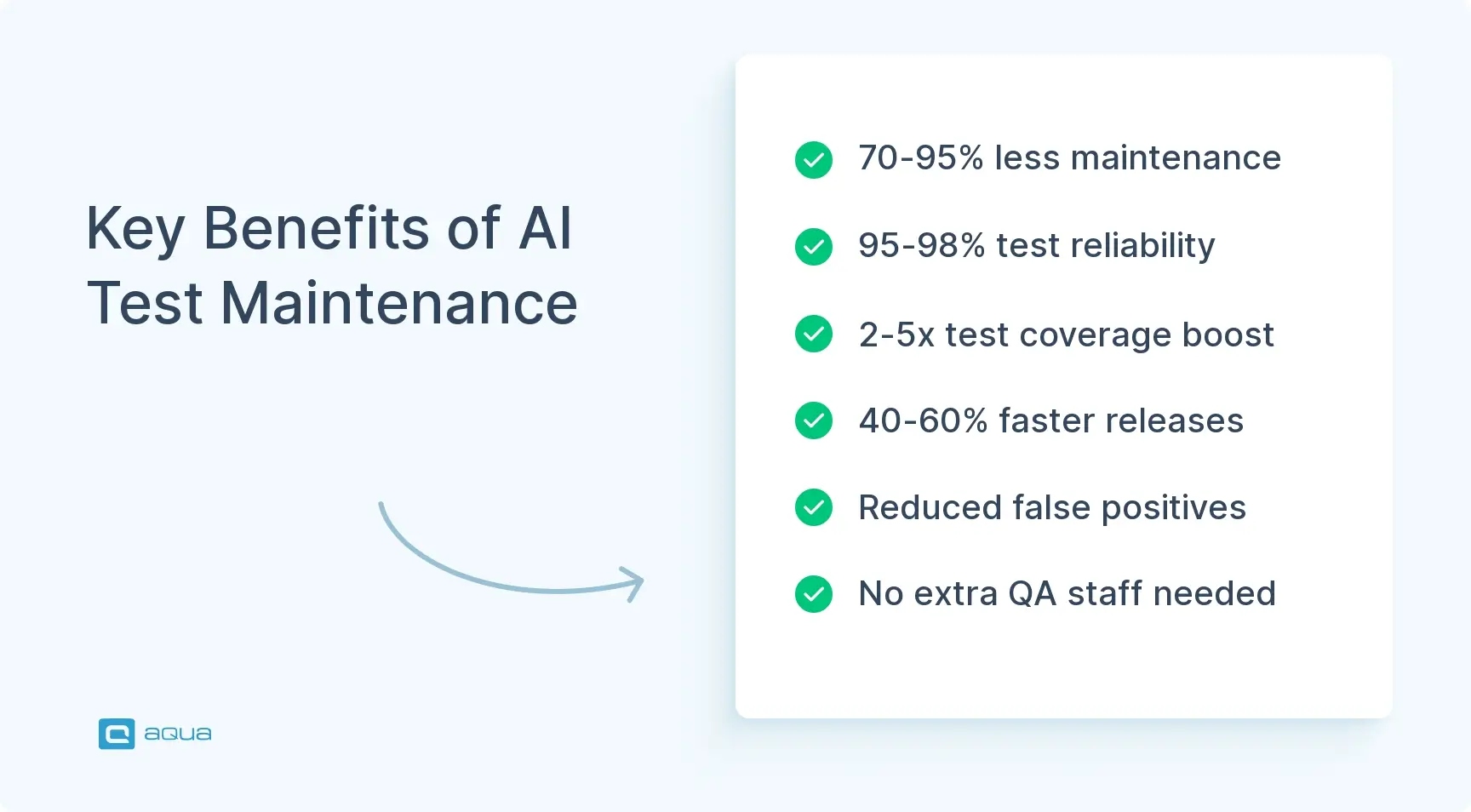Key Takeaways
- AI test maintenance solutions reduce test script maintenance effort by 70-95%, allowing QA teams to focus on creating new tests instead of fixing broken ones.
- Self-healing technology builds comprehensive element fingerprints using dozens of attributes, enabling tests to continue running even when UI elements change.
- Organizations implementing AI-powered test maintenance report expanding test coverage by 200-500% without adding staff, simply by redirecting effort from maintenance to creation.
- Test reliability improves from typical rates of 70-75% to 95-98% with AI maintenance, nearly eliminating false positives that undermine team confidence.
- The traditional test maintenance bottleneck consumes up to 50% of QA effort, with 73% of test automation projects failing primarily due to maintenance challenges.
With traditional automation, each UI change triggers a cascade of broken tests. AI-powered self-healing identifies elements even after developers completely restructure the DOM, maintaining test continuity without manual intervention. Discover how this technology is transforming testing economics 👇
Understanding the Test Maintenance Bottleneck
Test maintenance hits hardest where it should hurt least: in your automated tests. You invested in test automation to save time. Instead, you’re spending more time maintaining tests than you ever spent running manual ones.
Here’s what happens. A developer changes a button ID from “login button” to “user login button.” Dozens of automated tests that relied on that selector break immediately. Your dashboard floods with failures. These aren’t actual bugs. The tests just can’t find the elements they need anymore. One small change in the application cascades into hours of test script updates.
Manual test cases face similar problems, but automation amplifies them. A manual tester sees the button changed and adapts instantly. An automated test script blindly searches for an element that no longer exists and fails. Multiply this across hundreds or thousands of automated tests, and the maintenance burden becomes crushing.
The numbers show how severe this problem is:
- Up to 50% of QA effort goes to test maintenance instead of creating new tests or finding bugs.
- 73% of test automation projects fail with maintenance challenges as a primary cause.
- 68% of automation initiatives get abandoned within 18 months because maintenance becomes unsustainable.
- 84% of “successful” implementations still require 60% or more of QA time just for maintenance.
- The problem compounds as your application grows. Each new feature, UI change, or architectural shift creates ripple effects throughout your test suite. The maintenance burden doesn’t grow linearly. It explodes exponentially.
This affects more than just your QA team. When tests fail because of script issues rather than actual defects, developers lose confidence in automation. They start ignoring test results or skipping automated validation entirely. Your tests become worthless.
The real cost goes deeper than hours spent updating scripts. Your QA engineers focus on maintenance instead of expanding test coverage or performing exploratory testing. Developers get delayed feedback when automation can’t keep pace with changes. Defects slip through to production because you can’t maintain comprehensive coverage.
This creates a vicious cycle. Maintenance consumes more resources. Your team has less capacity to improve test architecture or implement better practices that would reduce future maintenance. The burden keeps growing.
Breaking this cycle requires a different approach. Traditional test scripts can’t adapt to application changes on their own. That’s where AI comes in.
The Role of AI in Test Maintenance
AI in software testing transforms test maintenance from constant manual work into an automated process. Traditional automation follows rigid scripts. AI-powered test maintenance introduces adaptability that mirrors how human testers respond to application changes.
Understanding elements beyond exact matches
Traditional tests rely on exact matches for element selectors. AI test maintenance builds comprehensive fingerprints of elements using dozens of attributes beyond just IDs or XPaths: visual characteristics, relative positioning, text content, and surrounding context. When an element changes, AI recognizes it through these alternative identifiers.
Self-healing that actually works
When a test encounters a changed element, self-healing systems don’t immediately fail. They intelligently search for the element using alternative attributes, update the test with the new locator, and continue execution without human intervention. This mimics how a human tester adapts. The login button moved, but it’s still recognizable as the same button. AI finds it and updates the test automatically.
Predicting problems before they happen
AI brings predictive capabilities to test maintenance. Machine learning models analyze patterns in application changes and test failures to predict which tests will likely break with upcoming releases. Maintenance shifts from reactive firefighting to proactive prevention. Your team focuses resources on high-risk areas and addresses potential issues before they cause failures.
Optimizing test suites intelligently
AI identifies redundant tests, consolidates overlapping coverage, and eliminates obsolete test cases. This intelligent pruning keeps test suites lean and maintainable while maintaining comprehensive coverage. Some AI systems even suggest refactoring opportunities to improve test architecture and reduce future maintenance needs.
Visual testing that sidesteps selector problems
Visual AI validates what users actually see, the rendered interface, rather than relying on technical element selectors. When developers change implementation details but maintain visual consistency, visual tests continue functioning without updates. This works especially well for applications with frequently changing UIs or frameworks that generate dynamic IDs.
Continuous learning that improves over time
AI test maintenance gets better with use. Each successful healing action, pattern recognition, or optimization becomes training data that improves future performance. Maintenance becomes progressively more automated as AI systems gain experience with your specific application. The system learns your application’s patterns and adapts accordingly.
This adaptability addresses the root causes of maintenance challenges instead of just treating symptoms. AI doesn’t eliminate test maintenance entirely, but it transforms the burden from manual script updates to oversight of an intelligent system that handles most changes automatically.
Test maintenance takes up too much time in fast moving development cycles. You need a platform built to handle this problem from the ground up.
aqua cloud puts all your test assets in one searchable repository. The nested test case functionality means you update a reusable component once and it changes everywhere. Teams typically cut redundant maintenance work by 70% this way. The AI Copilot is trained on testing concepts and learns your project context, so it generates and updates test cases that actually make sense. You get 100% visibility and traceability between requirements, tests, and defects, showing you exactly what needs maintenance and why. aqua integrates with the tools you already use like Jira, Azure DevOps, and Confluence, so your workflow stays intact.
Reduce test maintenance overhead by up to 70% while expanding coverage with aqua's AI-powered test management
Implementing Self-Healing Test Automation for Test Maintenance
You understand why AI helps with test maintenance. Now let’s look at how self-healing test automation actually works.
How self-healing captures element fingerprints
Self-healing starts during test creation. AI systems capture comprehensive data about each UI element, not just the primary locator, like an ID or XPath. They build an element fingerprint that includes dozens of properties: CSS selectors, class names, text content, relative position, size, color, and relationships to surrounding elements. This multi-attribute identification provides backup options when individual properties change.
What happens when a test encounters a broken locator
A test runs and hits a locator failure. Instead of immediately failing, the test enters recovery mode. It attempts to find the missing element using alternative attributes from its fingerprint. AI algorithms prioritize which alternative identifiers to try based on historical success rates and your specific application context. If button text has remained more stable than IDs in your app, the system prioritizes text-based identification.
When the element gets located through an alternative method, the test continues execution and records the healing action. The system then updates the test script with the new, working locator, either automatically or pending your approval, depending on configuration. Tests stay functional even as your application evolves.
Setting up governance and thresholds
Not all healing actions should proceed automatically. Critical workflows might need human review before script updates get applied. Less sensitive areas can benefit from fully automated healing. Most platforms let you configure different thresholds for different test types or application areas.
When elf-healing isn’t magic. There are limitations. If an element gets completely removed or its functionality fundamentally changes, no amount of self-healing makes a test pass. The goal is to eliminate false failures caused by minor implementation details while still catching actual functional issues.
Combining self-healing with good test design
The most successful implementations pair self-healing with good test design practices. Tests built around user journeys and business processes, rather than technical implementations, give AI systems a clearer intent to understand. This clarity improves healing accuracy and ensures tests validate what matters: the user experience, not implementation details.
Self-healing technology handles the repetitive work of updating locators automatically. Your team focuses on designing meaningful tests and investigating real failures instead of chasing broken selectors.
Tests will always require maintenance and upkeep but implementing some of the above should help stop the bleeding. In terms of automating too much or the wrong things, that seems like an opportunity for everyone to come together and agree on the valuable parts or high priority flows. When I automate a UI test I try to keep it to things that would block a customer or fundamental functionality.
Strategies for Effective Test Maintenance Management with AI
Implementing AI for test maintenance requires more than deploying technology. You need a strategic approach that combines tools, processes, and team alignment. Here’s how to make it work.
Start with a clear assessment
Before implementing AI solutions, audit your existing test suite to understand maintenance pain points. Which tests break most frequently? What types of application changes cause the most failures? Where does your team spend the most maintenance time? This baseline helps you target AI implementation where it delivers the greatest impact and lets you measure success over time.
Roll out in phases, not all at once
Start with a contained pilot project with clear success metrics. Pick test suites with high maintenance burdens but moderate complexity. This lets your team gain experience with AI capabilities, refine processes, and demonstrate value before expanding to more critical or complex areas.
Prioritize tests strategically
Focus your initial AI implementation on:
Business critical tests – Core business processes and revenue-generating paths that matter most
High maintenance tests – Tests with expensive maintenance history or frequent breakage
Frequently executed tests – Tests running most often in CI/CD pipelines where failures create the most disruption
Moderate complexity tests – Start here before tackling the most intricate scenarios
Establish governance and approval workflows
AI makes intelligent decisions about test updates, but human oversight remains important, especially for regulated industries or business-critical processes. Set up tiered approval levels:
Auto approve – Minor locator updates to non-critical elements
Review before commit – Significant changes to important workflows
Manual only – Critical security or compliance-related tests
Train your team properly
Your QA team needs training beyond just tool usage. They need to understand how to design tests that work effectively with AI systems. Tests built with AI capabilities in mind achieve better healing rates and require less manual intervention than tests retrofitted with AI later.
Integrate with your existing workflow
Connect your AI testing platform with source control, CI/CD pipelines, and defect tracking systems. This integration enables automatic test updates, provides visibility into healing activities, and creates feedback loops that improve both testing and development practices. Strategies for long-term test maintenance work best when AI fits seamlessly into your existing processes.
Measure what matters for maintenance
- Maintenance hours per test
- Self-healing success rate
- False positive reduction
- Test reliability improvement
- Release cycle acceleration
Review and improve continuously
Schedule periodic sessions where your QA team evaluates how AI handled specific test failures and healing opportunities. This feedback tunes the system, improves future decisions, and builds team confidence in automated updates.
Communicate the business value
Frame AI test maintenance as a strategic initiative, not just a technical tool. Help stakeholders understand how reduced maintenance overhead translates to business benefits: faster releases, improved quality, expanded coverage, and more efficient resource use. This strategic framing secures ongoing support and resources for your AI testing initiatives.
These strategies set the foundation for successful AI test maintenance. But what kind of results can you actually expect when you implement them? Let’s look at the concrete benefits organizations are seeing.
Benefits of AI-Driven Test Maintenance
AI-driven test maintenance delivers substantial, measurable improvements that change how testing works. These benefits create immediate operational advantages and long-term strategic value.
Dramatic reduction in maintenance effort
The most immediate benefit is reduced maintenance time. Organizations consistently report 70 to 95% decreases in time spent maintaining test scripts after implementing AI-powered solutions. This transforms how QA teams allocate resources.
Significantly improved test reliability
AI test maintenance improves test reliability, the consistency with which tests provide accurate results. Traditional test suites typically achieve 70 to 75% reliability, with remaining executions producing false positives where tests fail due to script issues rather than actual defects. After implementing AI maintenance, organizations regularly achieve 95 to 98% reliability, nearly eliminating all false positives.
When your tests actually work consistently, developers start trusting them again. No more “yeah, that test fails all the time, just ignore it” conversations. A failing test means something’s actually broken. That shift alone changes how your whole team thinks about quality.
Expanded test coverage without adding staff
When you’re not constantly fixing tests, you can actually write new ones. Teams routinely double or triple their test coverage without hiring anyone. You can go from testing 40% of your critical workflows to 95% in a few months. More coverage means catching bugs earlier, which is the whole point.
Faster release cycles and time to market
Without the test maintenance bottleneck, you can ship faster. Teams typically cut their release time by 40-60%. Ship faster, respond to customers faster, beat competitors to new features.
Improved team satisfaction and retention
Nobody got into QA to fix flaky tests all day. People want to write new tests, find real bugs, and improve the product. When you automate the boring maintenance work, your QA folks can do the job they actually signed up for. Teams report happier engineers who stick around longer.
Insights into application quality
You start noticing patterns in which tests need the most fixing. If the same areas keep breaking, that’s usually a sign your code needs refactoring. This feedback helps you improve not just your tests, but your actual application architecture.
Breaking the scaling limitation of traditional automation
Traditional testing hits a wall pretty fast. More tests mean more maintenance. At some point, you’re spending more time fixing broken tests than actually improving quality.
AI test maintenance changes the math. You can expand your test coverage without the maintenance costs piling up at the same rate. This lets you validate quality at a scale that wasn’t practical before.
The longer you use it, the better it gets. The AI learns from each fix and gets more accurate with your specific application. Most teams see maintenance drop by 80% initially, then climb to 90-95% as the system learns your patterns.

Best Prompts for AI Test Maintenance
AI can significantly reduce your manual work in test maintenance in different ways. In this section, we will help you:
- Use AI to analyze test failures
- Generate self-healing locator strategies
- Identify patterns in your test suite that lead to chaotic automation
Don’t spend hours debugging broken selectors or manually updating test scripts after every UI change. You can use AI to diagnose issues, suggest fixes, and optimize your entire test architecture for long-term maintainability.
Prompt 1: Diagnose Test Failures and Generate Self-Healing Locator Strategies
Prompt:
Use Case: When a critical test breaks after a sprint deployment and you need to quickly understand why and implement a more resilient fix.
Expected Outcome: You’ll receive a detailed analysis of the failure, multiple locator options, and ready-to-implement code that includes fallback logic. This turns a 2-hour debugging session into a 15-minute fix with better long-term stability.
Prompt 2: Audit Your Test Suite for Maintenance Hotspots
Use Case: When you need to strategically reduce maintenance burden but don’t know where to start or which tests are draining the most resources.
Expected Outcome: A data-driven maintenance roadmap. It should identify your biggest pain points and provide concrete refactoring steps. As a result, you might reduce maintenance time by 40-60% by focusing on the highest-impact changes first.
Prompt 3: Generate Smart Test Architecture for Minimal Maintenance
Use Case: When starting a new test automation project or refactoring existing tests to be more maintainable from the ground up.
Expected Outcome: A complete, implementation-ready test architecture blueprint that embeds maintenance-friendly practices from day one. This approach reduces future maintenance costs by 70-80% compared to ad-hoc test creation and provides clear patterns your entire team can follow.
These prompts can help you with specific automation or analysis tasks. But what if you could do this in one click, directly inside your testing workflow? That’s exactly what aqua does.
aqua is an AI-powered test management tool that brings these prompt-based benefits to life, instantly, without switching context. The AI Copilot analyzes your test failures, suggests optimal locator strategies, and even generates maintenance-resistant test cases based on your project’s specific patterns. You get the intelligence of these prompts built directly into your test management platform, with nested test cases that update everywhere when you change them once, and complete traceability showing exactly what needs maintenance and why.
Transform your QA with 98% time savings and AI that truly understands your project
Conclusion
AI test maintenance solves the biggest problem in test automation: wasting half your time fixing tests instead of writing new ones. Teams cut maintenance work by 70 to 95%, expand coverage by 2 to 5 times, and ship 40 to 60% faster. When considering what are the most efficient AI tools for reducing test maintenance, look for self-healing capabilities that integrate with your existing setup and get smarter over time. The goal is to stop tests from breaking in the first place.

















